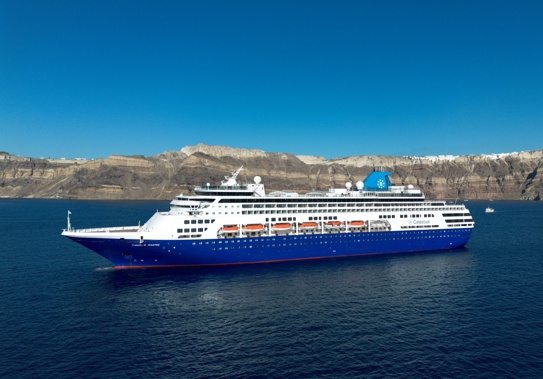
Has a Greek Islands cruise been flirting with your imagination? Recently, I renewed my Greek Islands love affair, joining my sister on a week-long adventure cruising the Aegean Sea aboard Celestyal Journey. The flagship vessel for Celestyal Cruises is deployed on their most iconic cruise, Idyllic Aegean, which is a 7-day highlights reel of the region. It’s like the Aegean’s greatest hits, with port calls in Mykonos, Santorini, Crete, Kusadasi, Thessaloniki and Milos. From Ephesus —site of one of the Seven Wonders of the Ancient World— to the cube houses and windmills of Mykonos and blue-domed churches of Santorini, the Aegean is as dreamy as reality gets.
My abiding affection for the Greek Islands was first hatched 25 years ago when I worked on-board Royal Olympic Cruises as a DJ, during my big OE. I was lucky enough to land the gig on their flagship, TSS Stella Solaris, which was the pride of Greece, sharing the treasures of the Aegean with the world. That torch has passed to Celestyal Cruises, the Greek owned and operated line, headquartered out of Piraeus. The world is indeed a village. While I was dining on Celestyal Journey, I suddenly recognised the head waiter, Pavlos Dalampiras. This proud 70-something Greek previously worked with me aboard the Stella Solaris. Pavlos has now been working on cruise ships for five decades – and he’s certainly lost none of his magnetic charisma!
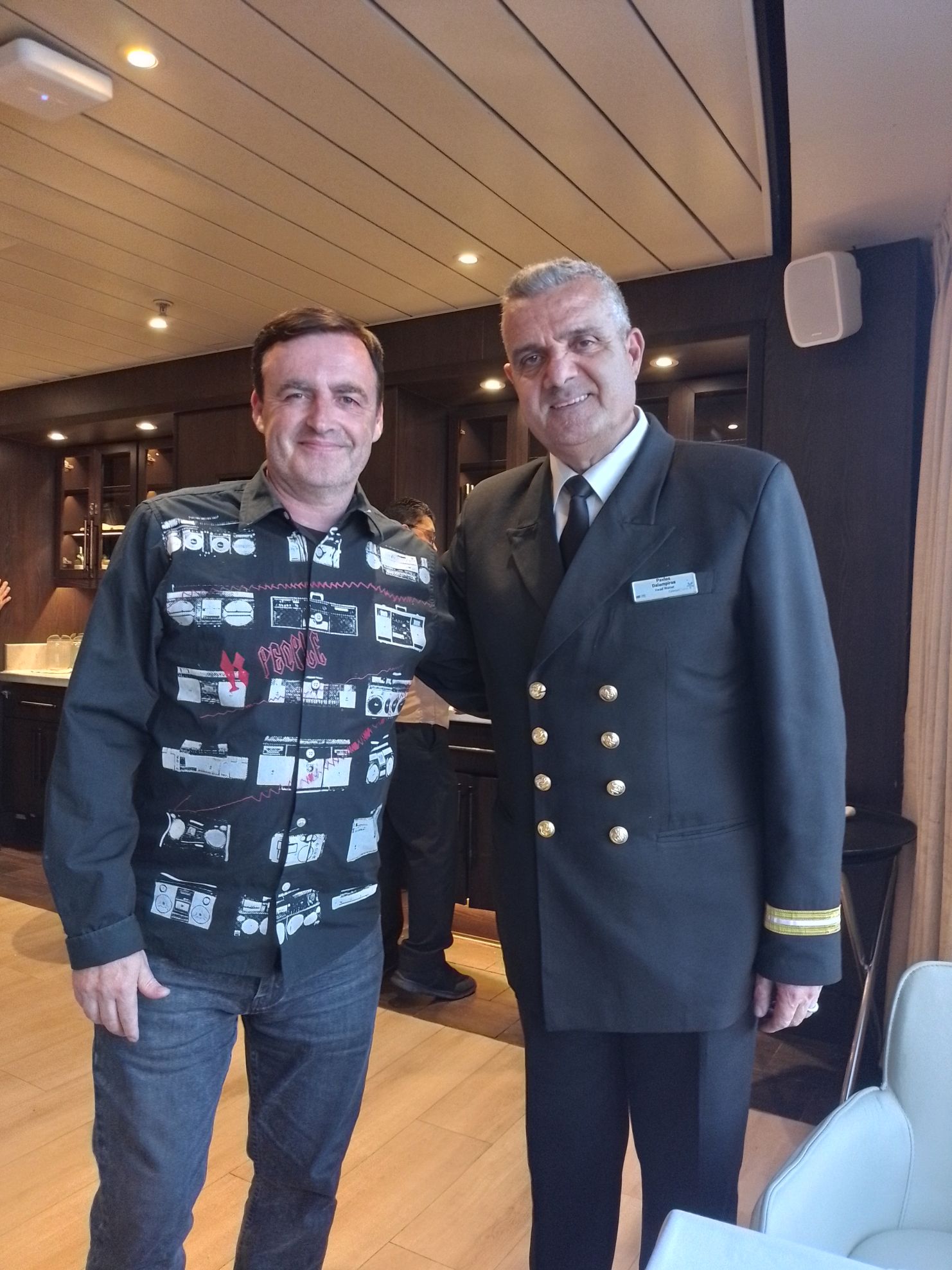 Mike and Pavlos on the Celestyal Journey. Photo / Mike Yardley
Mike and Pavlos on the Celestyal Journey. Photo / Mike Yardley
Mega-ships continue to wow the world with all their boundary-pushing titillations, but the Aegean Sea is far more conducive to cruising on a mid-sized ship, because there’s generally no sea days. It’s the on-shore, not on-board experience, that is the starring attraction, and it’s the smaller ships like Celestyal Journey that enable a far more seamless, stress-free experience when boarding and disembarking. It’s a breeze.
After reacquainting myself with the crumbling glory and mythic grandeur of ancient Athens, my week-long cruise set sail from the city’s bustling port of Piraeus. Mykonos and Santorini remain the perennial poster children of the Greek Islands, the twin rock stars that any self-respecting cruise itinerary will include. No Greek island is more synonymous with carefree vibes, gloss and glamour than Mykonos. At just 85 square kilometres Mykonos is a pint-sized island, but she crackles with excitement and is absurdly photogenic. The crowds can get packed, complete with a regular parade of fashionistas and preening celebrities, but the mass of humanity is magically subdued by the cubist charms of the main town, Chora.
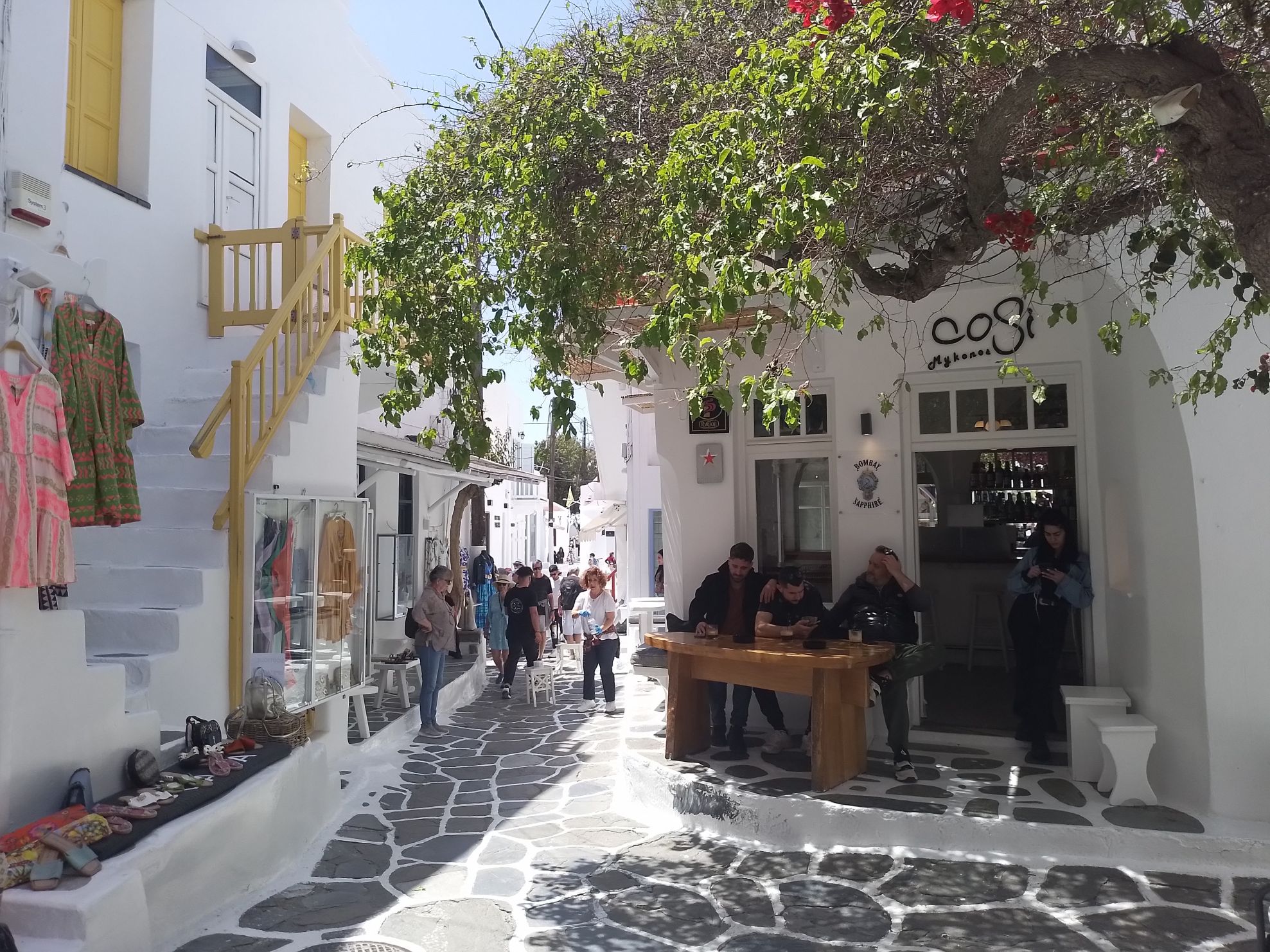 Chic laneway shopping in Mykonos. Photo / Mike Yardley
Chic laneway shopping in Mykonos. Photo / Mike Yardley
Lose yourself in the winding lanes, lined with gleaming white cubiform townhouses, typically adorned with painted blue doors. On my latest swing through Mykonos, I was struck at how even more and more luxury brands have stamped their presence with their own standalone stores, but amid the big brands, Chora (pronounced Hora) still brims with local, independent boutiques, galleries and fabulous gift stores. Favourite spot for bites and cocktails? The stirring strip of Little Venice is like a painting made real, but for an unsurpassed view of the endless blue, the Veranda Bar is where you’ll want to head. Housed in an 18th century building, Veranda serves all-day dining, while the cocktails are legendary. Try an Aegean’s Blue: ouzo, banana liqueur, blue curacao, banana juice and fresh lime.
The fellow superstar of the Cyclades is unquestionably Santorini, which jolts the senses of even the most jaded traveller. Cruising into that vast caldera and gazing up at the multi-coloured cliffs, crowned by that sweeping tiara of whitewashed houses of the main town Fira, is drama writ large. The surreal landscape is a relic of what was probably the biggest eruption in recorded history, pulverising the island three and half thousand years ago, which also gave rise to the legend of Atlantis. The force of the eruption triggered giant tsunami waves that smashed into the coastline of modern-day Israel. In more recent times, volcanic activity has been minimal, but a devastating 7.8mag earthquake savaged the island in 1956.
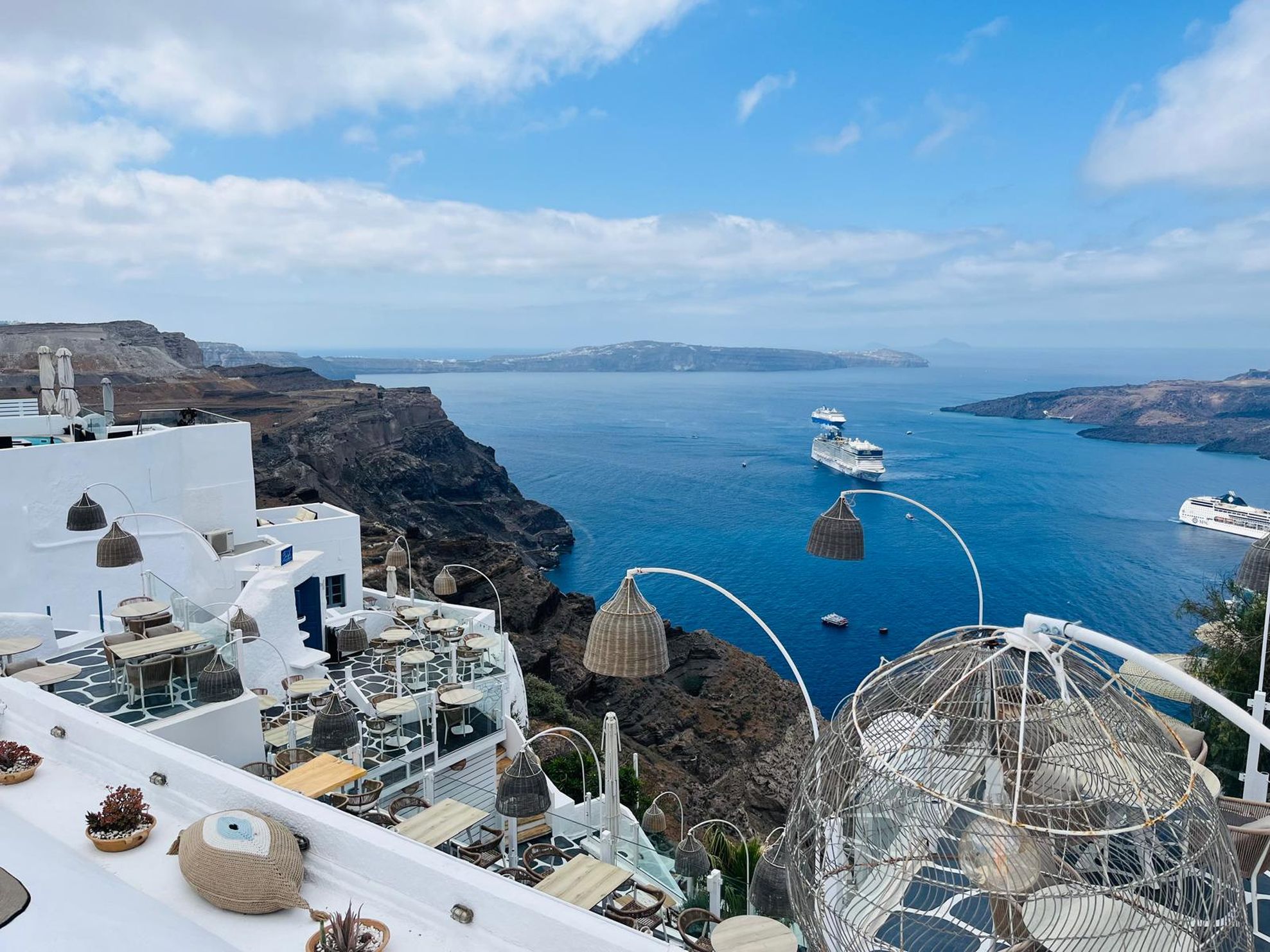 Caldera views from Fira, Santorini. Photo / Mike Yardley
Caldera views from Fira, Santorini. Photo / Mike Yardley
After you have tendered ashore from your ship, your biggest dilemma is how to reach the summit of the caldera. The cable car is most appealing, but if multiple ships are tendering, the billowing queues can see you waiting several hours for a ride up. No thanks! Your remaining options are choosing between walking up the 600 stone steps, that zigzag up the cliff-face to Fira. Or you can jump on a donkey and let them do the footwork. You’ll be aware that the donkey rides have attracted regular flak from animal rights activists, but I’m pleased to report that the dozens of donkeys I saw plying the route all looked to be in excellent health and were being regularly fed and watered. A 100kg passenger weight limit was also imposed several years ago, for the welfare of the donkeys. It remains strictly enforced. I opted for patting the donkeys, while I lugged my carcass up those 600 steps to reach the summit of the caldera, 1000 feet high. Take it at a leisurely pace and you’ll knock it off in 30 minutes. It’s also a rather virtuous way to burn-off buffet restaurant overindulgence! Reward yourself with a cable-car ride for the home run.
Up top in Fira, the real wonder of Santorini is that it exceeds all glossy picture-postcard expectations. Like an enormous crescent moon, the island encloses the pure blue waters of its caldera, the core of that ancient volcano. As you’d expect, Fira groans with an arsenal of alluring bars and restaurants, but my pick of the bunch is Volcano Blue. The white and baby blue colour palette sets the tone, atop the caldera, for sublime seafood dishes, where the fish is handpicked every morning from the day’s catch. Dishes include fava puree with octopus in vinegar; fried squid with caper sauce; and fresh mussels marinated in olive oil, garlic, wine and paprika.
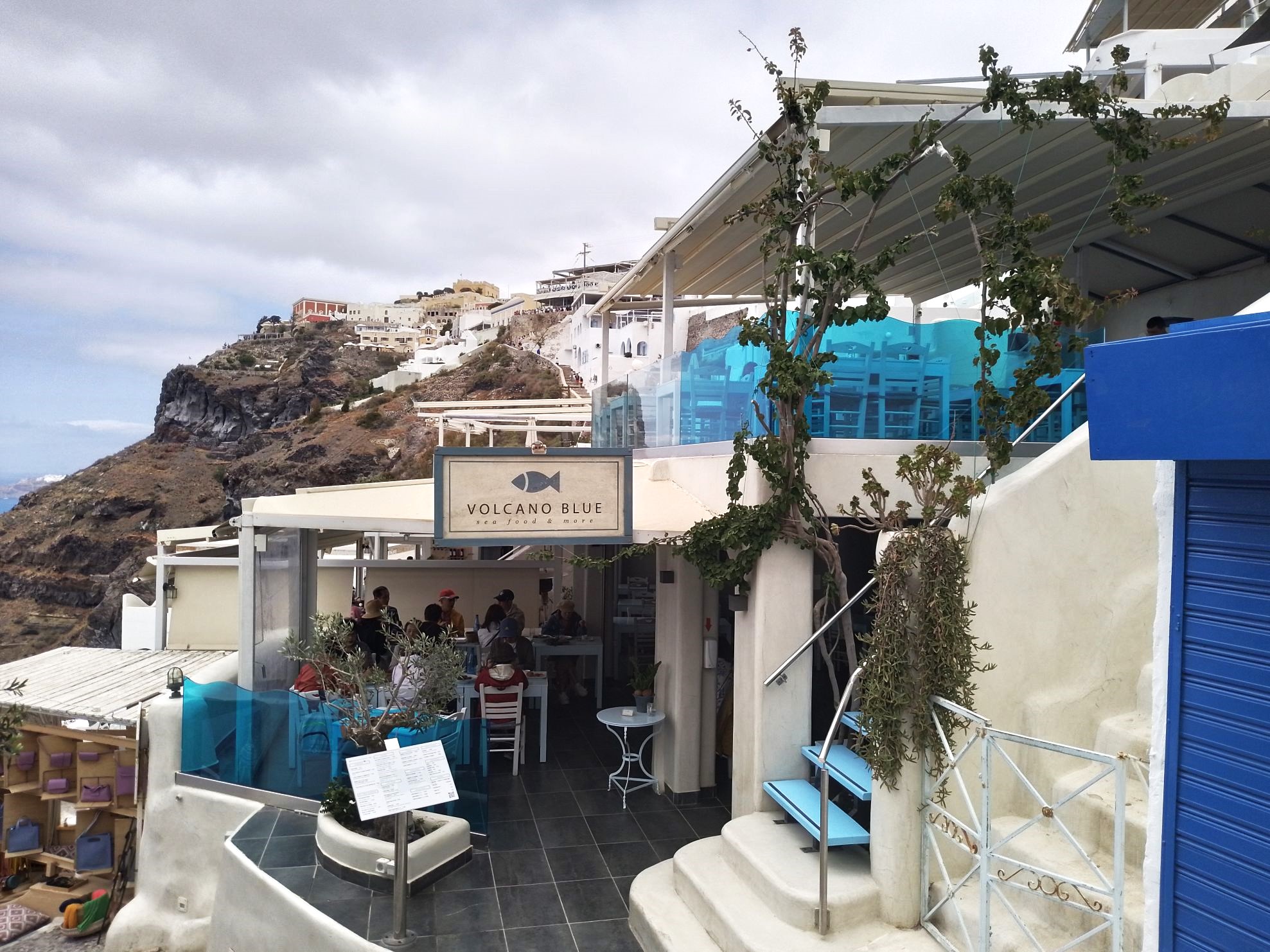 Volcano Blye in Santorini. Photo / Mike Yardley
Volcano Blye in Santorini. Photo / Mike Yardley
Definitely take a jaunt to the northwestern point of Santorini, where the village of Oia embodies the renaissance of Santorini after the 1956 quake. Epic restoration work and luxury tourism transformed Oia into one of the catwalk-ready destinations in the world. It’s irrepressibly picturesque. Built on a steep slope of the caldera, many of its dwellings nestle in niches hewn into the volcanic rock. Oia gets more sunset time than Fira, so if you are visiting at twilight, the super skinny passageways can get very crowded, very fast.
Sailing into Crete was another highlight, in the morning calm of Heraklion’s stunning seafront and its 16th-century walls. Fishermen were up early tending to their nets ahead of bagging the catch of the day. Shore excursions delved into the Cretan countryside and the Palace of Knossos. Our easternmost port call was in the colourful Turkish waterfront town of Kusadasi. In the great atlas of Mediterranean antiquity, few cities shone as bright as Ephesus, which is a must-do excursion from Kusadasi, if you haven’t done it before.
Back in town, I soaked up the sun on Kusadasi’s sizzling beaches, browsed the buzzing bazaar and took a stroll up Pigeon Island which is steeped in history. This fortressed island, which is now connected to the mainland by a causeway, was first protected by a castle in the 13th century by the Genoese. Under the Ottoman Empire, the castle played a key function as a “Pirate Police Station” to stop piracy in the area. The renowned Ottoman admiral Barbarossa oversaw the castle’s extensions.
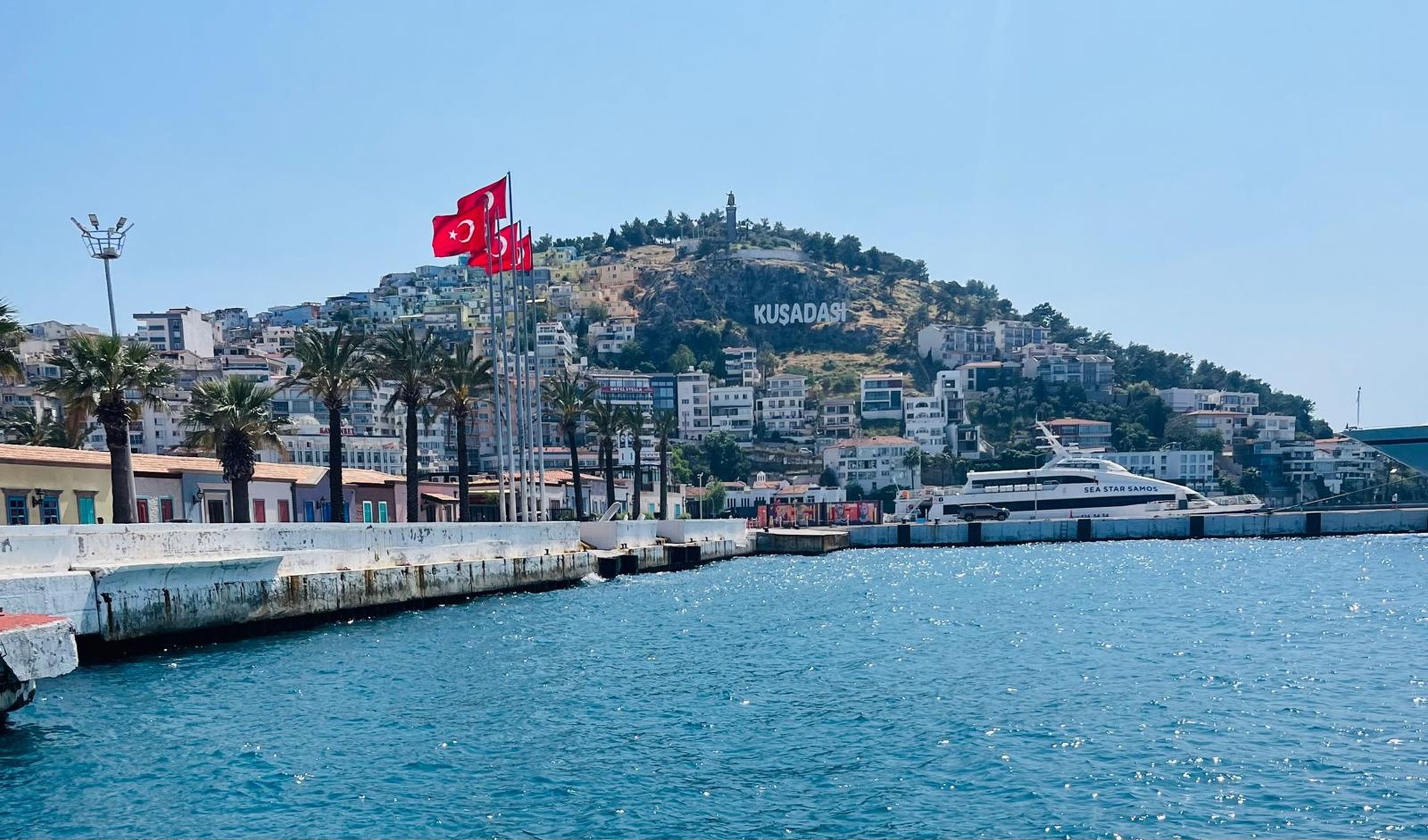 Sparkling Kusadasi. Photo / Mike Yardley
Sparkling Kusadasi. Photo / Mike Yardley
One of my favourite shore excursions was in Thessaloniki, the capital of northern Greece. It’s a gorgeous seaside city – relatively flat but layered in mountains of history. This historic capital of the Macedonia region was founded in 315BC. It would steal Athens’ thunder as a powerhouse, under Philip II of Macedon and his son, Alexander the Great. But the greatest surprise package is Celestyal Journey’s port call in Milos. This horseshoe-shaped Greek island in the western Cyclades, is an unsung pearl of the Aegean. It’s the isle where the Louvre’s prized Venus de Milo statue of the Greek goddess Aphrodite, was discovered in 1820. Volcanic by origin, Milos has a striking array of landscapes and beaches with backdrops of multicoloured cliffs and water that dazzles with crystalline greens and blues.
Its captivating geological formations are the result of undersea eruptions which piled up layers of lava and created a kaleidoscope of rock formations and sea stacks. The most spell-binding volcanic landscape is the lunar-like Sarakiniko Beach. This awe-inspiring formation of smooth white rocks, sandy coves and numerous sea caves are all washed in the most transfixing hue of sapphire and azure waters. with plenty of horizontal layering. Sarakiniko is apparently named after the Saracen pirates that used the caves as a shelter, as did the Ottomans and the Barbary pirates as a trusty hiding place. Pack your togs – this could be the dip of the trip!
Celestyal shore excursions in Milos also include the hill-top capital of Plaka, which feels like a walk-in fairytale village. It’s as beautiful Oia, just more rustic – and without the tourist hordes. Verina, which translates as twisted nautical knot, is a gorgeously atmospheric bar, is decked out with timber rafters, fishing net light fixtures and a seafarer’s portrait. Order the Sailor’s Punch, a mix of aged rum, pineapple, passionfruit, falernum liqueur, ginger and aromatic bitters and catch the sunset from the neighbouring church’s courtyard.
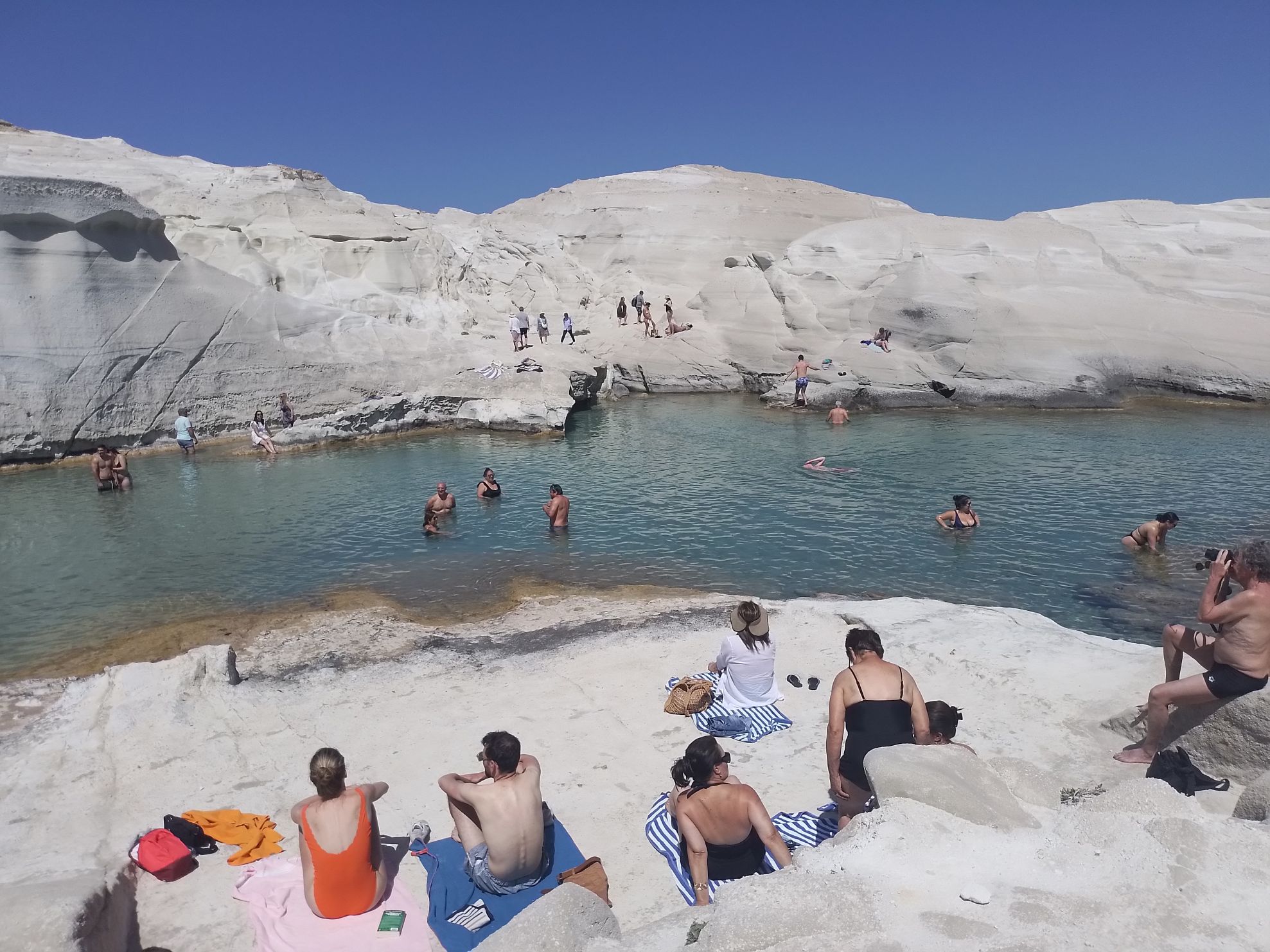 Spellbinding rock formations and swim spots in Milos. Photo / Mike Yardley
Spellbinding rock formations and swim spots in Milos. Photo / Mike Yardley
Cruising in such a blessed pocket of the world certainly makes you think harder about sustainability. Celestyal has certainly upped its game, committed to the protection of the environment and in the communities it operates in. Over 80% of water consumed on board is produced by sea water due to optimized Reverse Osmosis utilisation. Plastic bottles have been eliminated from the bars and dining venues. Disposable bathroom amenities are gone, in favour of refillable dispensers. Energy-efficient LED lighting has been installed throughout the ship, while food waste has seen the old-school large buffets replaced with smaller ones, which is more accurately calibrated to the guest count. I was also struck at how Celestyal works closely with the local Greek community as part of their ethical business practices. For example, the cruise line helps bring interactive exhibits from the Heraklion Museum in Athens to more remote areas of the Greek islands.
Cruise the Greek Islands the Greek way, where passionate hospitality, local pride in cultural heritage and insider knowledge are all part of the package. The seasoned pros at Celestyal Cruises deliver the only genuine Greek cruising experience, across the Aegean and Mediterranean. The standard Celestyal Experience package includes accommodation, all of your meals, drinks with meals, entertainment, gratuities, and a complimentary shore excursion discount. For added-value, upgrade to the Celestyal Plus+ Experience package, which includes more dining options, an enhanced drinks package, complimentary WiFi and a super-sized US$170 excursion discount. Celestyal’s Idyllic Aegean 7-day cruise from Athens takes you to Thessaloniki, Mykonos, Crete, Kusadasi, Santorini and Milos. For the best deals on all upcoming cruises and the full range of itineraries, head to https://celestyal.com
Mike Yardley is our resident traveller on Jack Tame Saturday Mornings.
Take your Radio, Podcasts and Music with you









